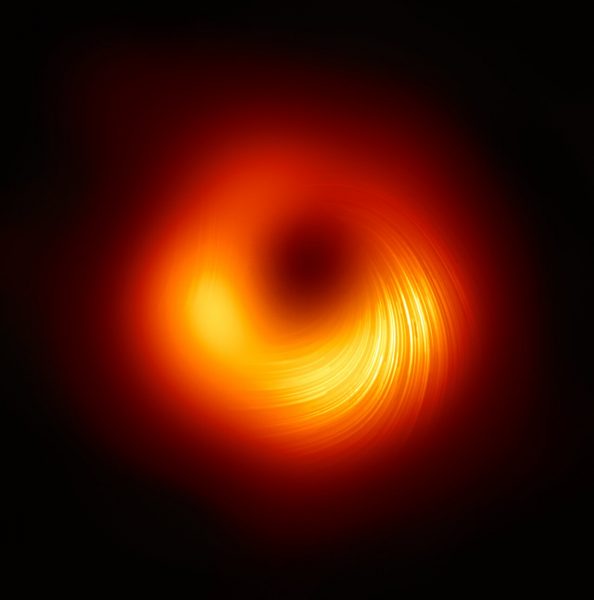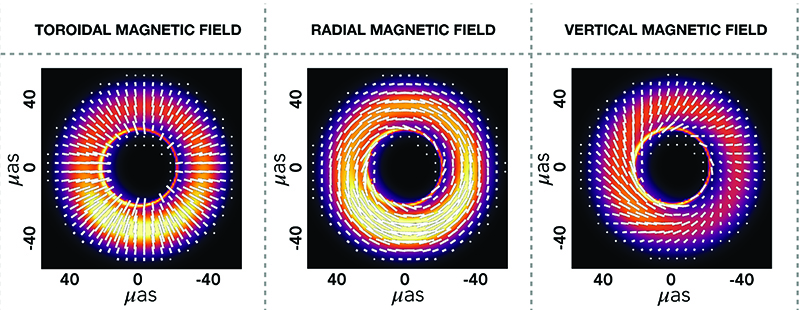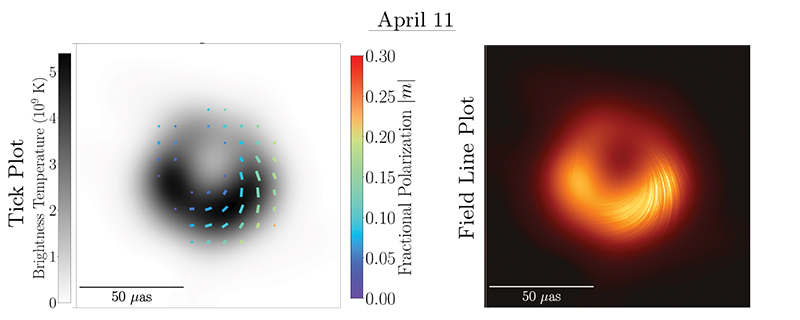Event Horizon Telescope data support the idea that magnetic fields control how black holes feed and grow.
The Event Horizon Telescope collaboration has unveiled new images of the black hole shadow at the center of the elliptical galaxy M87, which sits at the center of the Virgo Cluster some 55 million light-years away. These images, unlike the iconic one released in 2019, include polarized light — photons that shimmy at only certain orientations as they travel through space.

Event Horizon Telescope Collaboration
To the casual eye, the difference might not look like much: We’re still dealing with a glowing doughnut. But the polarization data contain key information about how magnetic fields behave near the black hole, information that astronomers have waited decades to get their hands on.
Magnetic fields are cosmic puppeteers. They control the flow of ionized gas as though they were complex marionette strings, helping (or hindering) the gas to move. Astronomers think magnetic fields play a crucial role in black holes’ growth, creating turbulence in black holes’ big fluffy gas disks that then robs the gas of its angular momentum and enables it to fall onto the central object. (Without that turbulence, black holes would go hungry.) Magnetic fields also power black holes’ galaxy-scale jets.
But this picture is largely theoretical. In order to catch magnetic fields pulling the strings close around M87’s black hole, astronomers have turned to polarized emission, which encodes information about the magnetic fields that the photons passed through.
As part of the 2017 campaign that produced the original black hole shadow image, the EHT team used a planet-spanning network of radio telescopes to observe synchrotron emission from the gas enshrouding M87’s supermassive black hole. Synchrotron radiation is emitted by electrons corkscrewing along magnetic field lines, and it’s highly polarized by nature.
To obtain the new results, the collaboration followed a similar method as before. First, they painstakingly combined the different telescopes’ data, then they split into multiple teams to reconstruct images using different software codes and methods. Finally, they averaged the images together. The task was extra challenging, however, because not only are the polarization signals weaker than the gas’s overall glow, but each telescope also saw the source moving through a different arc across the sky, rotating the polarization angle in a unique way, explains Monika Mościbrodzka (Radboud University, The Netherlands).
Magnetic fields naturally thread the gas disk around a black hole. As the accreting gas rotates it drags the fields around with it, wrapping them around the black hole and amplifying them. If the only magnetic fields present in the gas tutu were those wound up by the gas, then the polarization pattern would look like the left image in the series below.

adapted from EHT Collaboration / Astrophysical Journal Letters 2021
Instead, what the EHT team saw is this.

adapted from EHT Collaboration / Astrophysical Journal Letters 2021
The little tick marks indicate the direction and amount of polarization. There are two important things about this image:
First, there’s the polarization pattern. There’s clearly order to the pattern, but the image looks more like a combination of the center or right panels of the earlier diagram. That tells us that there’s a fairly strong magnetic field present that’s oriented differently than what would exist if it’s simply wrapped around the black hole by the accretion disk, explains Jason Dexter (University of Colorado, Boulder). “That would be the main science takeaway,” he says.
Second, there’s the polarization fraction. Synchrotron emission ought to be highly polarized (roughly 70%), but what we see here is only 10-30% polarized. The signal must have been scrambled, likely because the gas close to the black hole that the photons are traveling through is highly magnetized. The weakened polarization makes it hard to see what the magnetic field’s exact structure is.
But it also helps astronomers narrow in on what’s going on in the accretion disk.
To unravel the disk’s conditions, the EHT collaboration compared the data to more than 100 different simulations, encompassing a broad swath of possible gas densities, magnetic field strengths, and temperatures. Their conclusion is that we’re seeing relatively thin gas paired with magnetic fields that are strong enough to resist the gas’s inflow and affect how the gas moves. Theorists call this a MAD scenario, for “magnetically arrested disk;” the weaker-field situation is called SANE, for “standard and normal evolution.” (Lest you think astronomers have no sense of humor.)
Magnetic fields can resist the gas’s pull because they have a pressure associated with them, Dexter explains. Magnetic fields don’t like to be squeezed or twisted out of shape; they push back, like a spring when you try to unwind it. So long as the magnetic fields submit to being dragged along with the gas, they travel together. But if enough stubbornly oriented fields accumulate in the accretion disk’s inner parts, they can change how the gas falls onto the black hole or even choke off the flow.
“The conclusion that there are strong — or strong-ish — fields in the central accretion disk is almost certainly right,” says accretion expert Christopher Reynolds (University of Cambridge, UK), who wasn’t involved with the M87 studies. But he’s hesitant about using simulation comparisons to conclude that only MAD scenarios work. “This approach has always left me a little uncomfortable,” he admits. “What if the data are trying to tell us something that isn’t in the lexicon of those models?” The EHT astronomers agree, acknowledging that their set of scenarios is incomplete.
Notably, in 2015 Michael Johnson (Center for Astrophysics, Harvard & Smithsonian) and other members of the EHT team found signs of a similar level of polarization and orderliness in the emission from our own galaxy’s central black hole, Sgr A*. The work used fewer telescopes, so they couldn’t reconstruct an image. But the comparison is intriguing. “I think this is definitely pointing to a consistent story in these two systems,” Johnson says. Infrared observations of Sgr A* with the GRAVITY instrument in Chile have also indicated strong fields are at play.
Thus the new data might be direct evidence not only that magnetic fields provide the turbulence that forces gas to fall into the black hole, but also that the fields act like the nozzle on that inflow, controlling the rate of infall — and perhaps, this picture is true for more than just M87’s supermassive black hole. The results appear in two papers in Astrophysical Journal Letters.
References:
The Event Horizon Telescope Collaboration. “First M87 Event Horizon Telescope Results VII: Polarization of the Ring.” Astrophysical Journal Letters. March 20, 2021.
The Event Horizon Telescope Collaboration. “First M87 Event Horizon Telescope Results VIII: Magnetic Field Structure Near the Event Horizon.” Astrophysical Journal Letters. March 20, 2021.
 2
2









Comments
robert stenton
March 24, 2021 at 2:21 pm
Looks like Black Holes do have hair. Hope there will be more future information about this finding.
You must be logged in to post a comment.
Yaron Sheffer
March 24, 2021 at 5:29 pm
M87 has a prominent jet, and magnetic fields always play a part in confining jets that emerge along the rotational axis of the black hole.
You must be logged in to post a comment.
You must be logged in to post a comment.